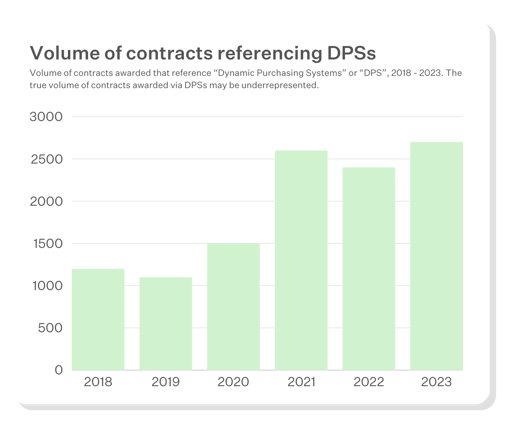The 2023 Procurement Act is set to bring a suite of new mechanisms that contracting authorities can use to award new work to suppliers.
One such tool is the 'Dynamic Market'.
In this quick-fire blog, we run through what exactly 'Dynamic Markets' are, how they differ from existing procedure types, and how suppliers and buyers alike can make the most of them.
***
This article is part of a series of articles on the 2023 Procurement Act.
Head to Tussell's Procurement Act Hub for all the information and resources you need to get Procurement Act ready.
Don't fancy reading? Watch the video version of this explainer 🎬
🔎 What are Dynamic Markets?
Dynamic Markets are a new purchasing tool being introduced under the 2023 Procurement Act.
Alongside frameworks and open frameworks, they are one of three mechanisms contracting authorities can use to create a pool of pre-approved suppliers before going out to tender for new work.
Dynamic Markets are an evolution of pre-Procurement Act 'Dynamic Purchasing Systems' (or DPSs).
DPSs act like framework agreements by providing a list of compliant suppliers, but unlike frameworks must be open for new suppliers to join throughout their entire lifetime. DPSs can only be established to facilitate the procurement of specific goods & services (namely, commonly used 'off-the-shelf' purchases).
Dynamic Markets, on the other hand, can be created for all procurement types. They must be open to new suppliers throughout their lifetime.
Dynamic Market, in essence, represent the wider introduction of the qualification system that had been used to procure utilities for many years.
⚙️ How are Dynamic Markets created, and how do they operate?
Any contracting authority can declare its intention to create a Dynamic Market at any time by publishing a Dynamic Market Notice.
A Notice must then be re-published once the Market officially begins, and also once it comes to an end.
The initial Dynamic Market Notice specifies the terms suppliers must satisfy in order to enter the Market - these must be proportionate and reasonable in relation to the complexity and nature of the contracts intended to be awarded via the Market.
These terms cannot be altered once this Notice has been published, or throughout its lifetime.
 Download Tussell's 2025 Public Sector Frameworks Report
Download Tussell's 2025 Public Sector Frameworks Report
Dynamic Markets have no maximum length, but any duration must be specified in its Dynamic Market Notice.
Once a Dynamic Market goes live:
-
Suppliers can apply to join the Dynamic Market at any point during its lifetime. The contracting authority must assess all applications and notify them of their status within a reasonable timeframe.
-
There is no limit to the maximum number of suppliers who can join a Dynamic Market.
-
Tenders intended to be awarded via the Market must be published publicly, and make reference to the fact that only members of the Market will be considered. All new or pending applications to join the Market must then be considered while this tender is open, however.
-
Contracts are then awarded by referencing a supplier's membership of the relevant Dynamic Market.
-
Fees may be charged to suppliers after they're awarded a contract via the Dynamic Market.
🛠️ What are Utilities Dynamic Markets?
As previously stated, Dynamic Markets can be used to purchase any type of good or service.
This is slightly different in the case of utilities procurement however. Dynamic Markets intended for utilities operate with a couple nuances:
-
Tenders intended to be awarded via utilities Dynamic Markets do not need to be published publicly, but only to the incumbent members of the Market.
-
Fees may be charged to suppliers both when awarding a contract, and when obtaining or retaining Market membership.
❓ Why are Dynamic Markets being introduced?
Dynamic Markets look to build on the relative success of their predecessor, Dynamic Purchasing Systems.
Tussell analysis indicates that between 2018 and 2023, the volume of contracts that reference "Dynamic Purchasing System" or "DPS" has increased by a staggering 125%.

DPSs offered contracting authorities many of the benefits of standard framework agreements, but with an added layer of flexibility by enabling suppliers to join them throughout their lifetime.
Dynamic Markets take it a step further, by expanding their remit to include all procurement types, not just commonly procured goods and services.
Learn more about Dynamic Purchasing Systems.
🚀 How can I make the most from Dynamic Markets?
Ahead of the go-live date for the new Procurement Act regulations in February 2025, there a few ways suppliers and buyers can plan ahead to make the most out of this new route-to-market.
For buyers
-
Dedicate time now to consider what goods or services you could start procuring through a homemade Dynamic Market. Given the open nature of Dynamic Markets, a wide array of suppliers should be able to provide these goods or services.
-
Ensure you've planned out the Dynamic Market's entry requirements thoroughly, ensuring they're both reasonable and proportionate to what you're after - these terms cannot be amended after it goes live.
-
Also, consider the resource implications of opening a new Dynamic Market. You need to have the internal capacity to monitor and consider new applications to your Dynamic Market(s) throughout their lifetime, and must respond to applicants within a reasonable period.
-
Consider how you utilise Dynamic Markets to encourage SMEs into your supply chain. By their open-ended nature, Dynamic Markets should be more accessible to time and resource-restricted SMEs.
For suppliers
-
Once the new Procurement Act goes live, make sure you're on the lookout for new Dynamic Markets - they represent a new, accessible way to facilitate winning work in the public sector, so don't miss the opportunity to join relevant ones in your niche.
-
That said, once you're on a Dynamic Market you're not guaranteed to win work. You'll still need to craft relevant, resonant tender submissions that align with the contracting authority's needs. Use data-led insight to understand their procurement footprint and the market's conditions, and fine-tune your offer.
-
If you're an SME, Dynamic Markets represent a great way to get a foothold in the public sector marketplace. Unlike framework agreements, you can apply to join a Dynamic Market at any time, meaning you won't be put under the same time limitations to access them.
*
Dynamic Markets are just one of the myriad of changes being introduced with the 2023 Procurement Act.
They should, in theory, provide an accessible mechanism for contracting authorities to expedite their procurement within a pre-approved pool of suppliers; conversely, suppliers - especially SMEs - should benefit from the ability to join an open-ended qualification system, and gain access to work they'd otherwise be excluded from.
Time will tell how widely and effectively Dynamic Markets are used, but if the ever-growing usage of their predecessor, DPSs, is anything to go by, Dynamic Markets should see wide-spread usage from February 2025.
***
This article is part of a series of articles on the 2023 Procurement Act.
Head to Tussell's Procurement Act Hub for all the information and resources you need to get Procurement Act ready.-1.png?width=450&height=330&name=Procurement%20Act%20Hub%20Graphics%20(1)-1.png)
Sources:
Nick Pimlott, Procurement Act 2023 - Frameworks and Dynamic Markets (Fieldfisher, https://www.fieldfisher.com/en/insights/procurement-act-2023-frameworks-and-dynamic-markets)
Emily Heard, Jessica Boardman, Procurement Bill Byte 5: Frameworks and Dynamic Markets (Bevan Brittan, https://www.bevanbrittan.com/insights/articles/2022/procurement-bill-byte-5-frameworks-and-dynamic-markets/)
Lucy Probert, Mark Fitzgibbon, Procurement Act 2023 Update 4 - what is the role of frameworks and dynamic markets in procurement? (Hill Dickinson, https://www.hilldickinson.com/insights/articles/procurement-act-2023-update-4-what-role-frameworks-and-dynamic-markets)




%20v1.png)












